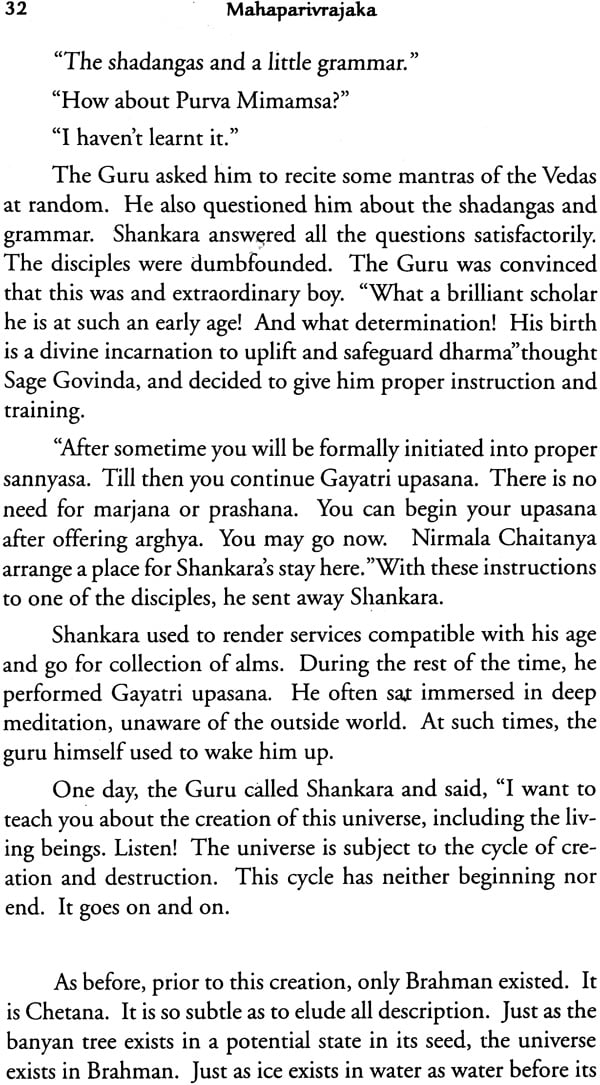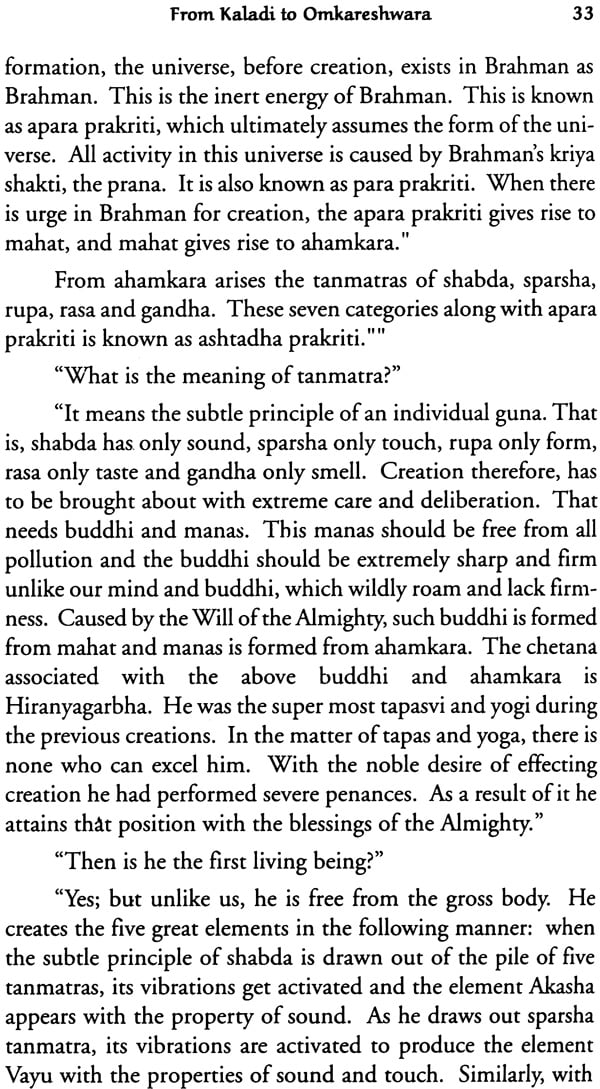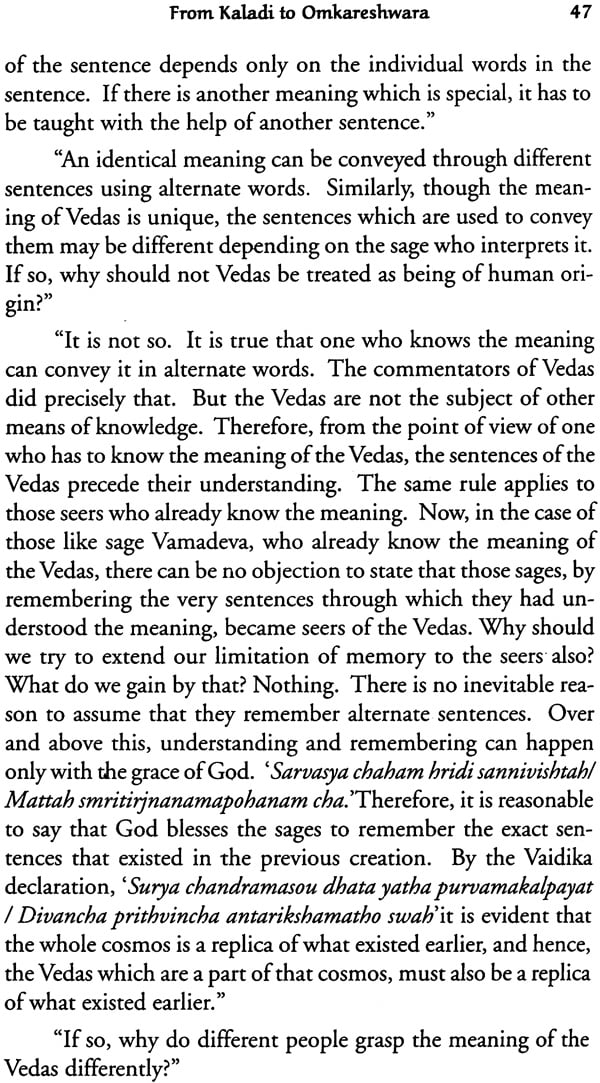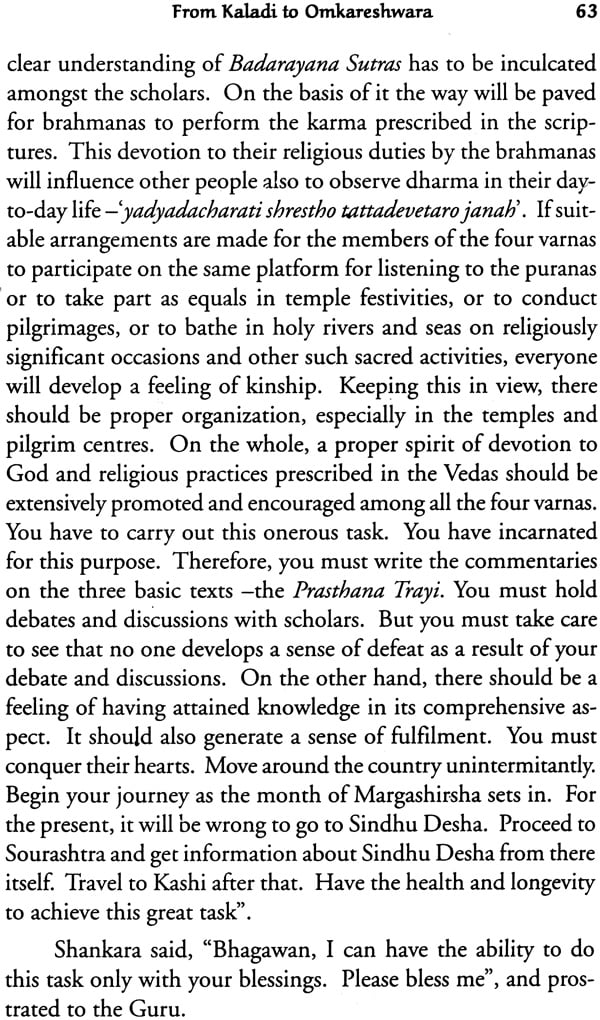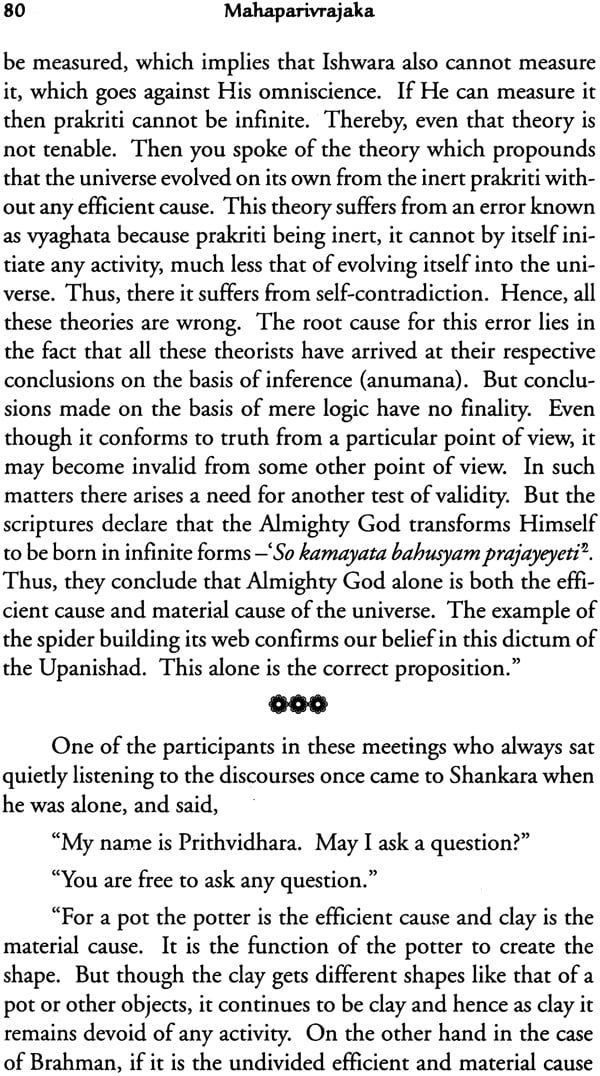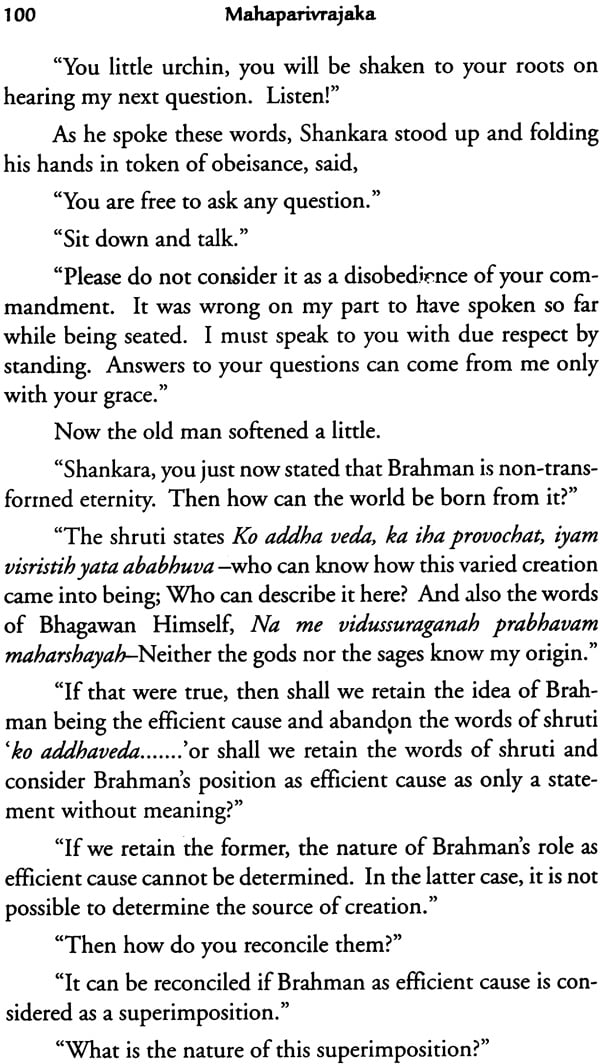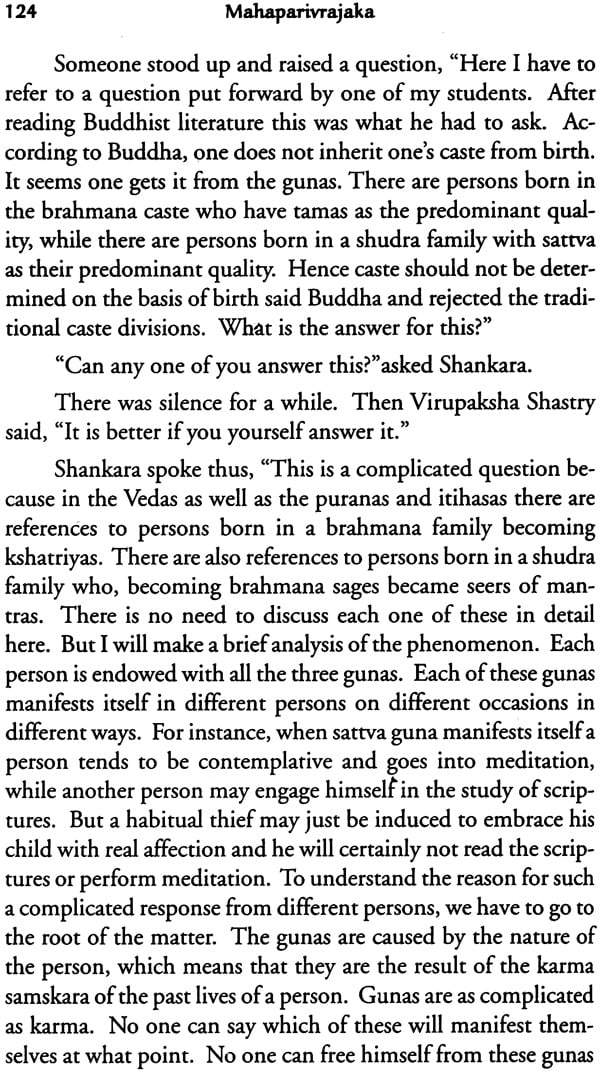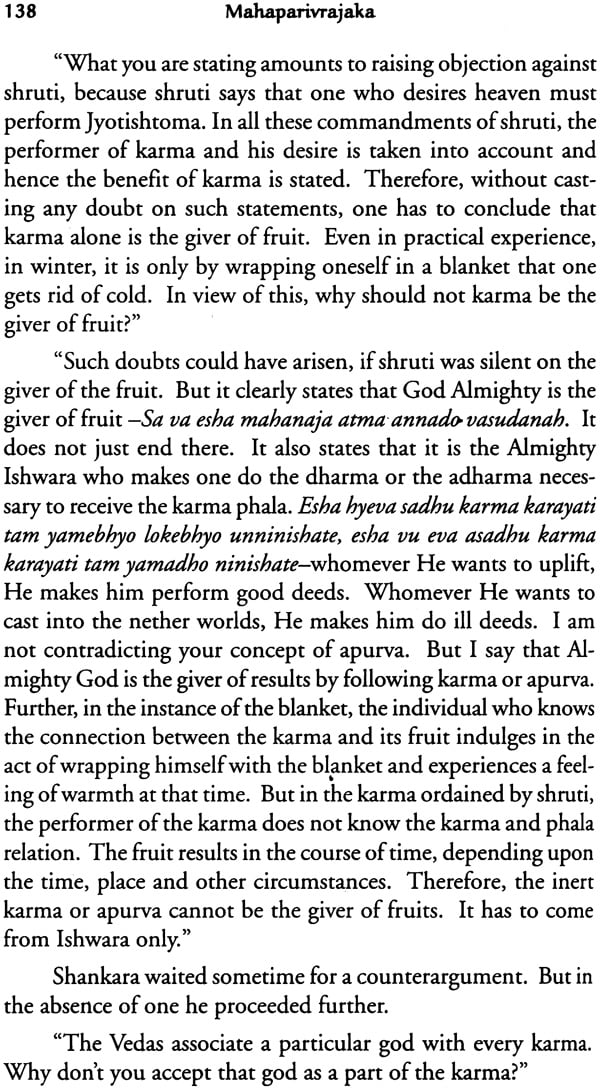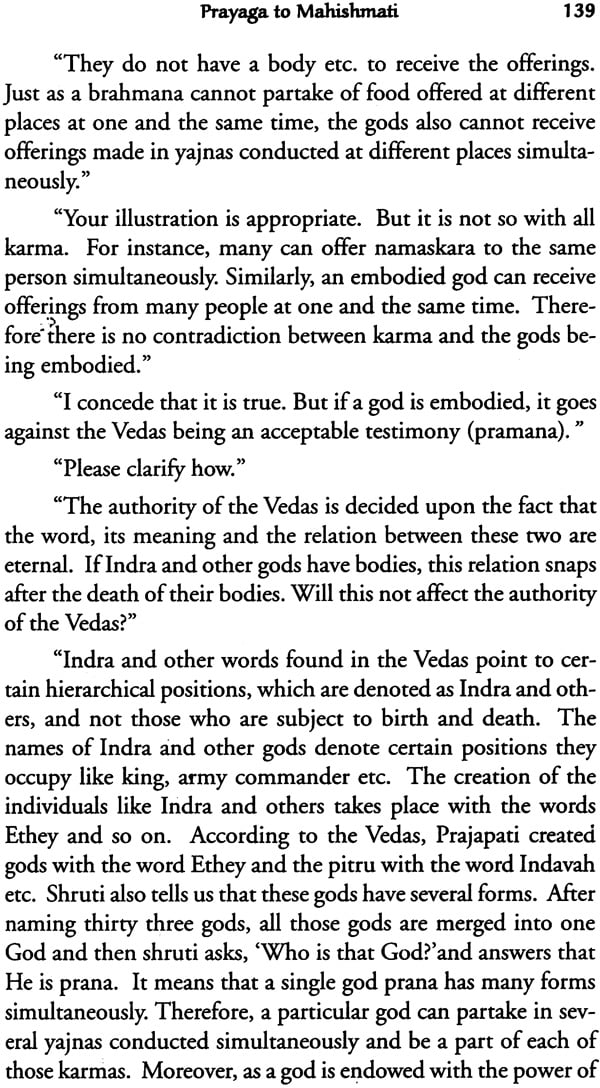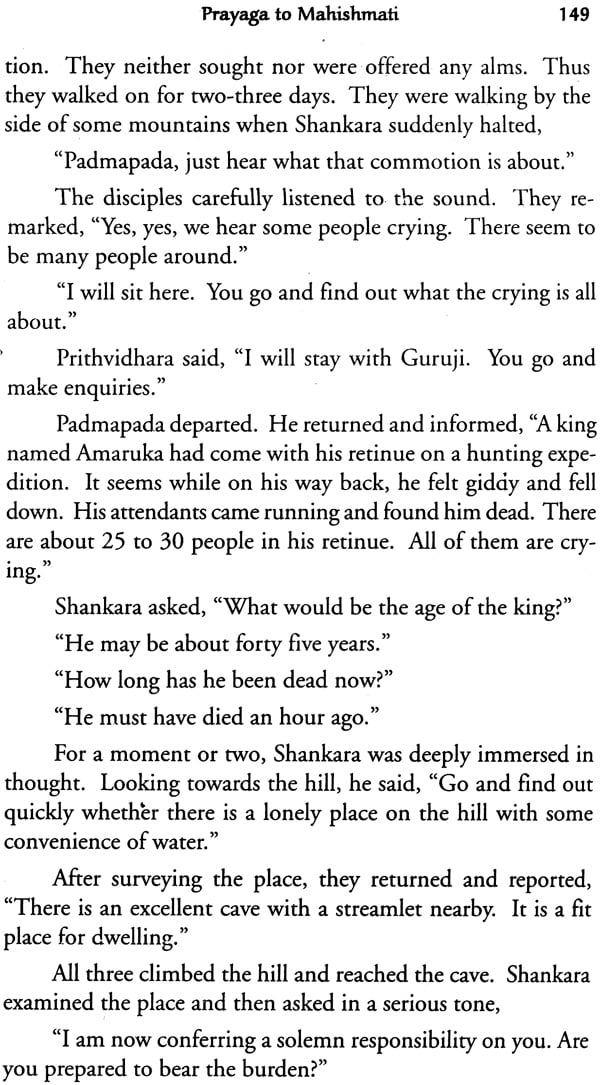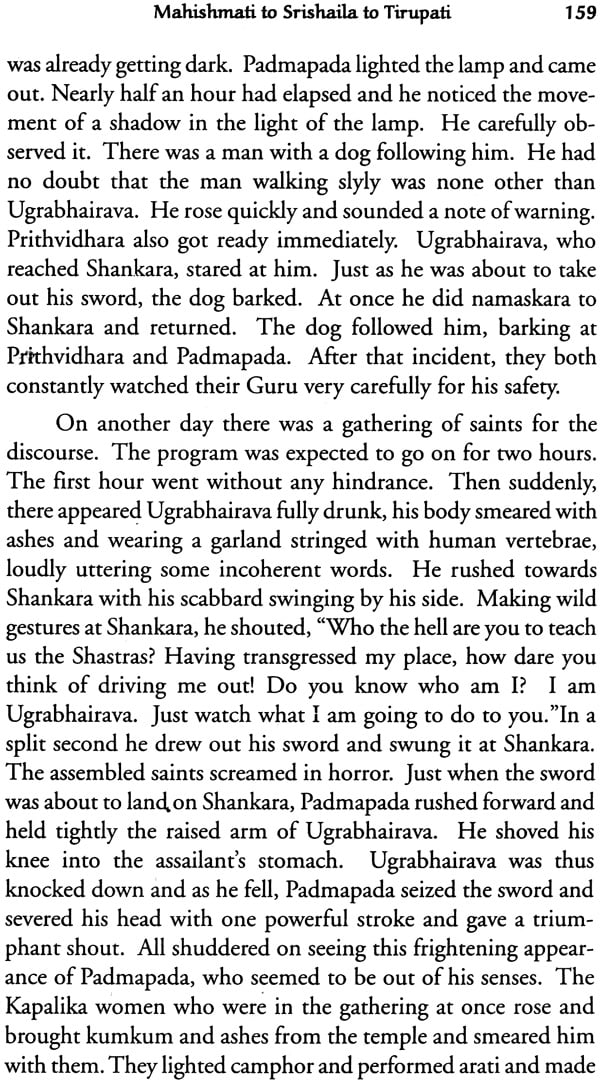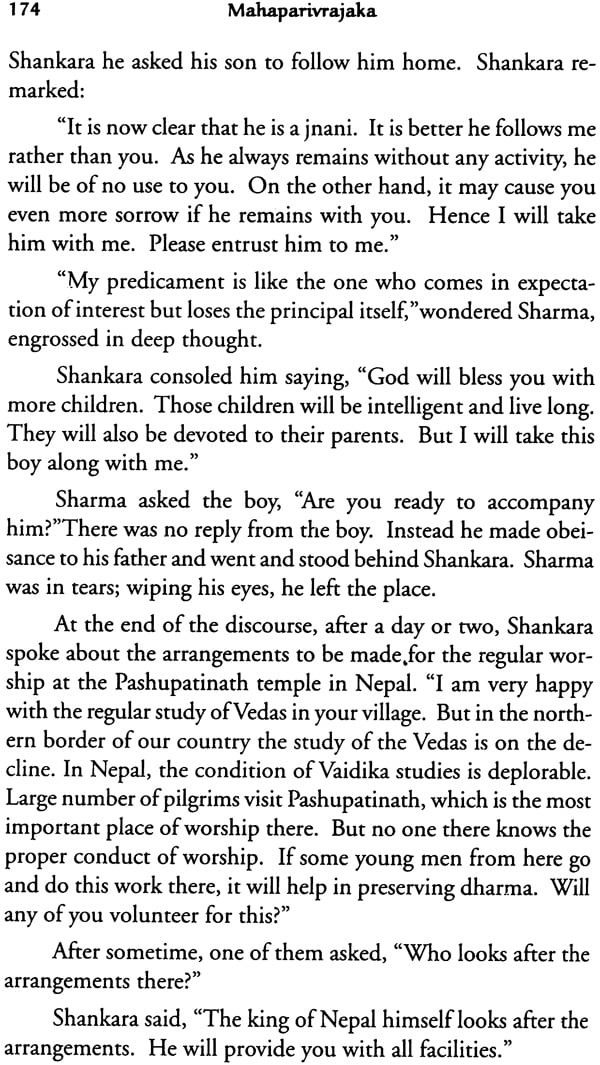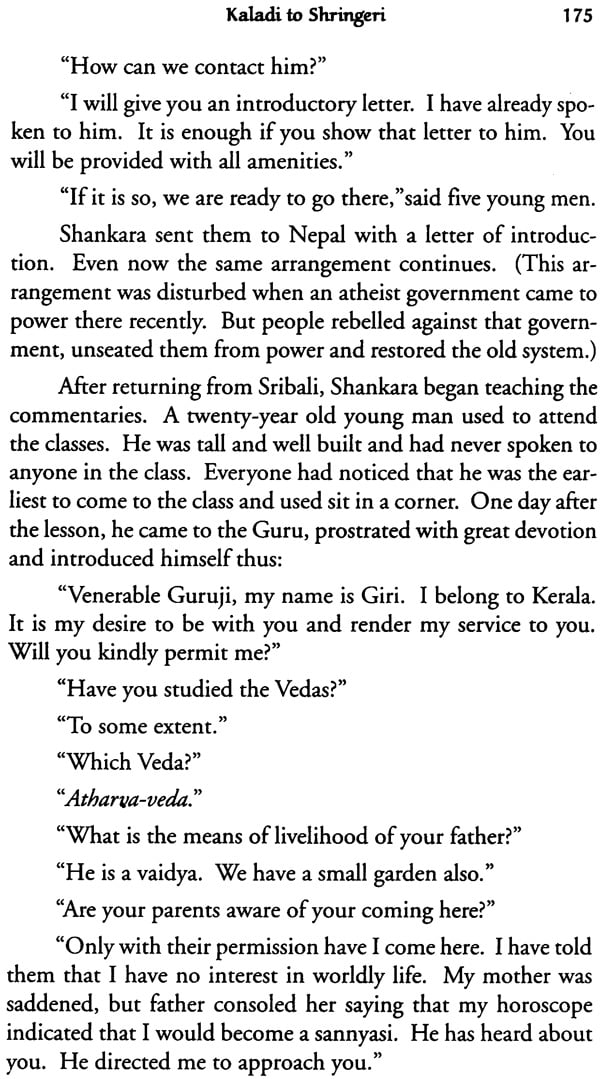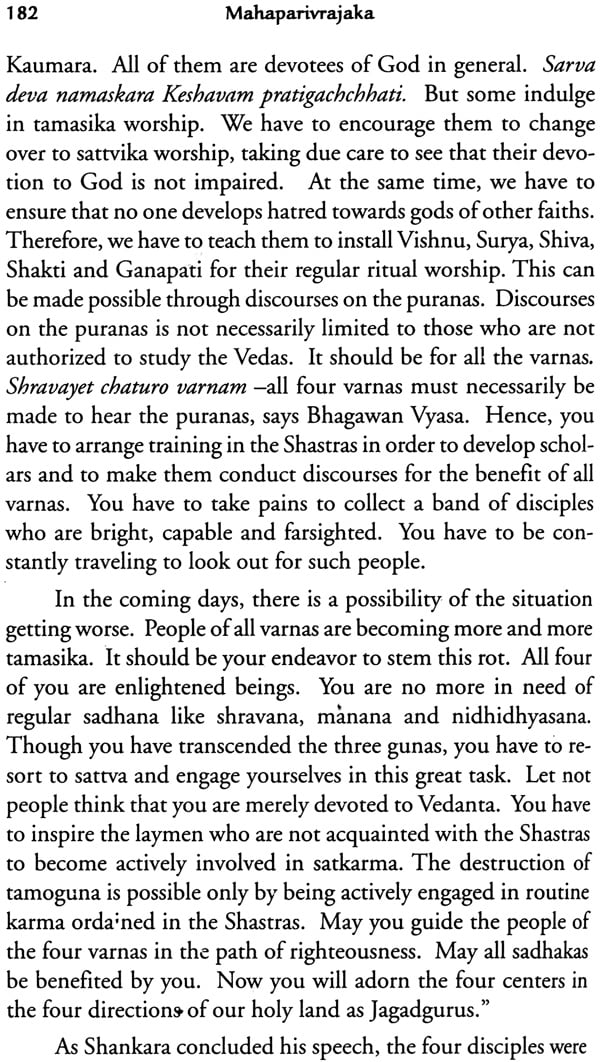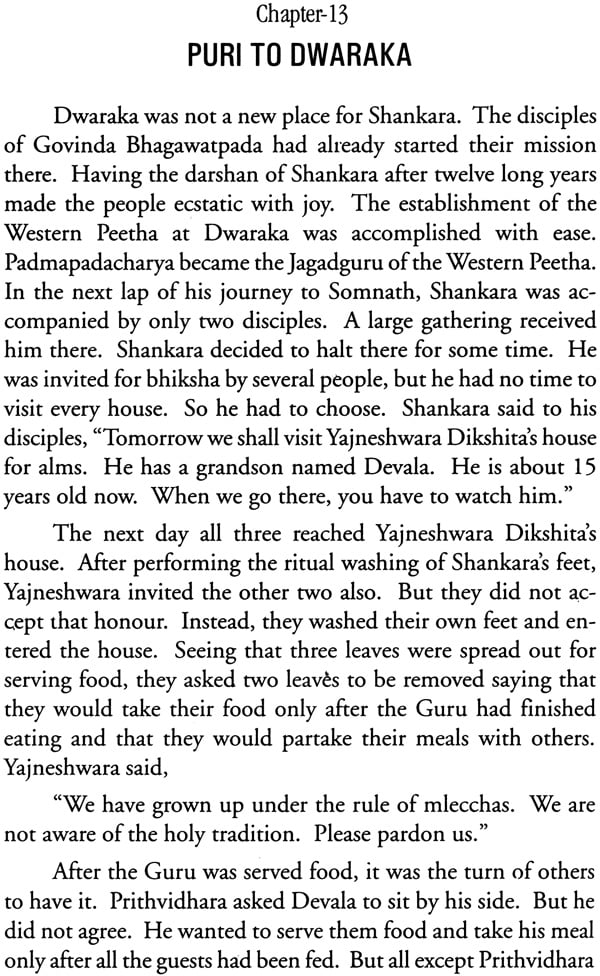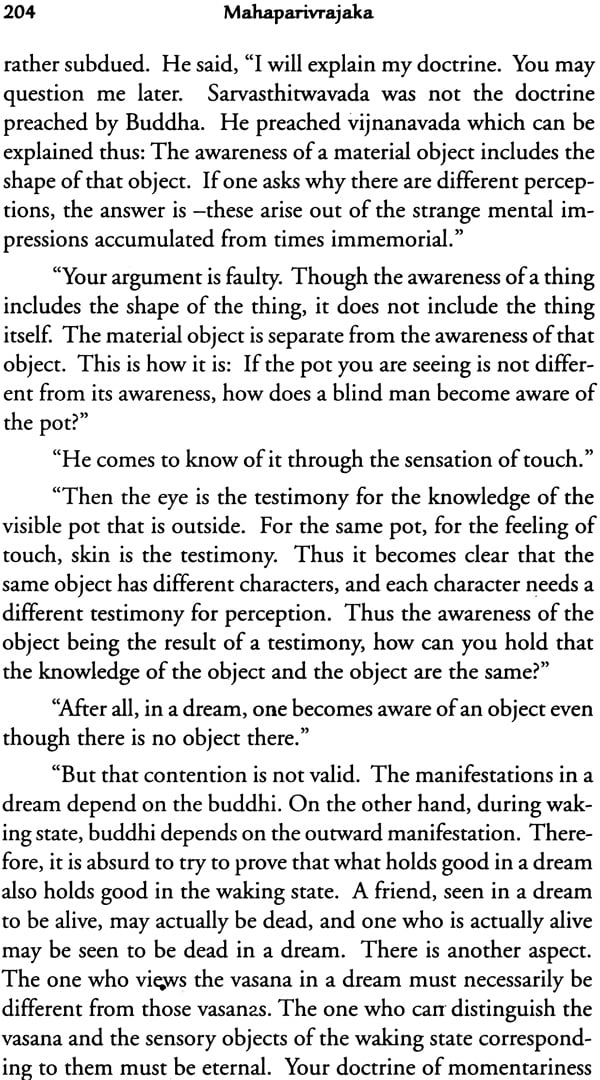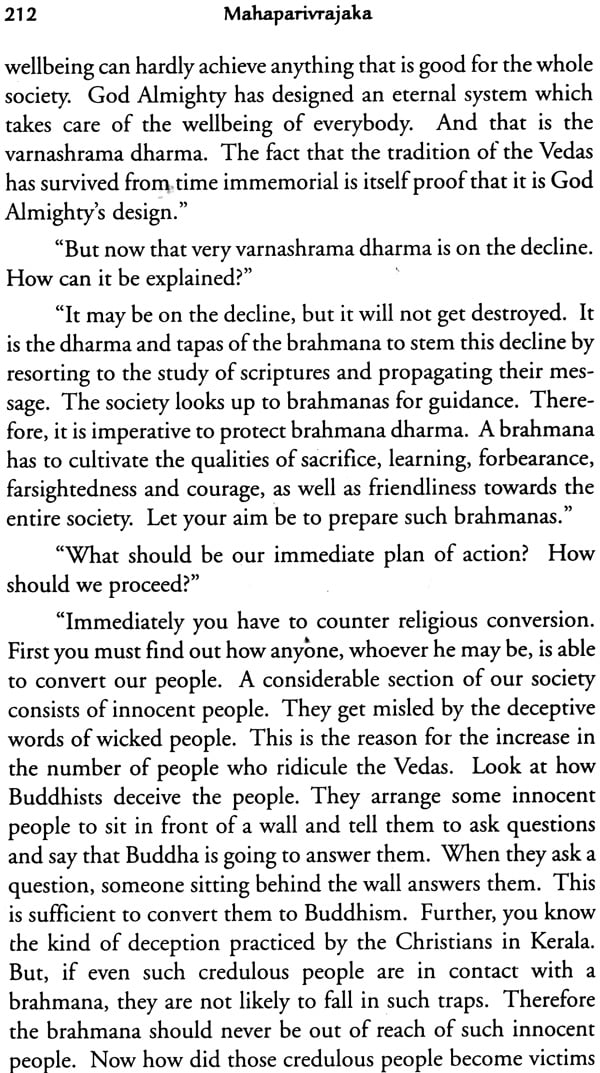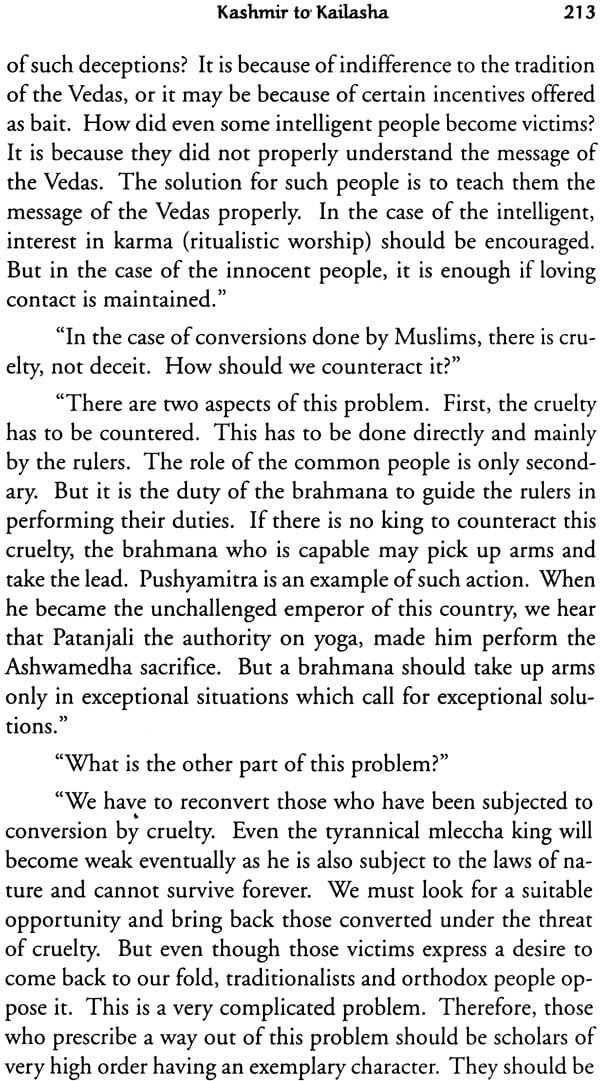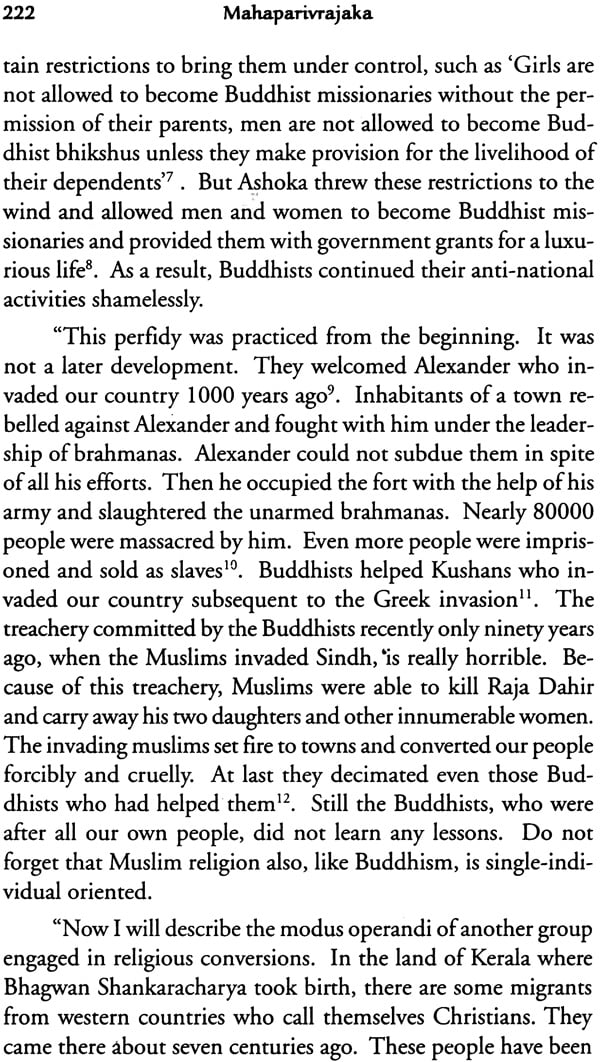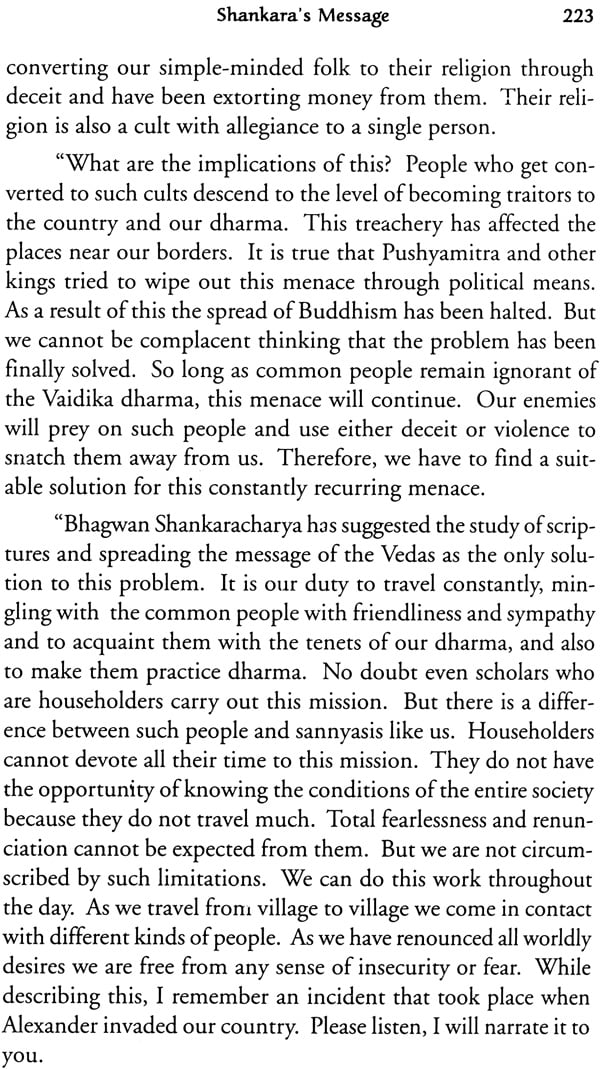
Mahaparivrajaka (A Novel Based on Shankaracharya''s Life and Philosophy)
Book Specification
| Item Code: | NAJ809 |
| Author: | Swami Paramananda Bharati |
| Publisher: | Chaukhamba Surbharati Prakashan |
| Language: | English |
| Edition: | 2014 |
| ISBN: | 9789383721795 |
| Pages: | 248 |
| Cover: | PAPERBACK |
| Other Details | 8.5 inch X 5.5 inch |
| Weight | 300 gm |
Book Description
This book describes the life and philosophy of Shankaracharya. It uses a fast paced narrative which reads almost like a novel. The book succeeds in exploring the depth and breadth of Shankaracharya's personality, witnessed in the part played by him in resurrecting a rapidly declining dharma. This biography is not written in a 'Western historical sense', rather, it follows the style of our timeless Puranas and includes inspiring material interspersed between stories about Shankaracharya. Indeed, it fills a gap felt by many; namely a book which explains Shankaracharya's philosophy in a simple and interesting manner. This is the greatest achievement of the book.
The author is a sannyasi in the lineage of Shankaracharya, having been initiated into sannyasa at Shringeri. Undoubtedly, he is one of the greatest scholars of Advaita Vedanta of this century and his pure life is a source of constant inspiration for his disciples.
Uttaram yat samudrasya Himadreshchaiva Dakshinam
There are several citations as above which depict the fact that Bharata which extends from the Himalayas in the north to the legendary Rama Setu in the south has been a nation from times immemorial, but modern intellectuals deny this fact. They cite the examples of kingdoms of the past being perpetually at war with one another and thus question how such people could constitute a nation. But those who raise this objection do not know the difference between a state and a nation as understood in our tradition. A king has the natural tendency of extending the boundaries of his kingdom. If he is devoid of this quality, the very essence of kingship is lost: "Asantushto dwijo nashtah, santushto hi mahipatih" - A discontented brahmana and a contented king are sure to be destroyed. It is something unique about Bharata that though there were different types of kingdoms in different places, and the kings were at war with one another, it has remained a nation from Himalayas in the north to the ocean in the south. "Samrajyam bhojyam swarajyam vairajyam parameshthyam rajyam maharajyamadhipatyamyam .... prithivyai samudra paryantaya ekahraat - Samrajya, Bhojya etc. are different kinds of states in the country. Nevertheless, it is one Rashtra - Nation." is what the Vedas declare. "Vayam rashtre jagriyama purohitah" - it is the bounden duty of the purohita to be vigilant and safeguard this unity. Such is the exhortation to the purohitas. If one asks, "What is the distinguishing mark of this nationhood?" It is to be found in the values and ideals that the people of this country cherish. It is the firm faith of our people that moksha is the ultimate goal of this life and that one should lead a life that is compatible with this ultimate ideal. Only because these values and ideals have still survived that people go on pilgrimage to innumerable holy places located in different parts of the country. Their ardent desire is to bathe in all the rivers of this country, as every river flowing through this land has the potency of washing off sins. The Kumbha Mela holds an irresistible attraction for all. The prevalence of such common beliefs and values can be attributed to the Vedas, the puranas, Ramayana, Mahabharata and other holy scriptures as well as the great sages who initiated these great traditions in this country. The Shastras give valuable guidance not only to the common man but also to warring kings. Even war has to be fought in a legitimate way as laid down in the Shastras. Keeping in view the kingly desire for conquest and extension of territories, the Shastras prescribe performance of Ashwamedha and the notion of a single sovereignty over the whole country. This spirit of unity and patriotism still survives in our people. When our country attained independence 64 years ago after a continuous struggle of nearly twenty five centuries, the incredible event of 600 kings voluntarily giving up their separate kingdoms to be merged in the new republic witnessed in this country, is something unheard of in the history of any other country of the world. Further, when the government declared the policy of "land belongs to the tiller", landlords voluntarily gave up their land to the government. Such a willing sacrifice can happen in no other part of the world. There would have been bloodbath if such a policy had been attempted in any other country. Thus, it is amply clear that Bharata was and continues to be a nation and will certainly survive as a nation. But those modern intellectuals who desire to know the essence of this dharma cannot do so unless they free themselves from the vicious influence of western culture.
Shastras reveal that even this dharma established by the sages of yore gradually loses its hold on the society in the course of time. Dharma which stands firmly on four legs in the Krita Yuga, with the advent of new yugas gets deprived of these supporting legs one by one, till in the Kali Yuga it is left with only one leg for its support. With the entry of the Kali Yuga, Parikshit, who was none other than the scion of the noble Pandavas, being the son of Abhimanyu and grandson of Arjuna, behaves like a depraved youth. Offended on getting no response to his query from Shamika, who was seated in deep meditation, Parikshit garlands him with a dead snake. If such is the effect of the Kali Yuga even on a person of noble descent, what could be its effect on common people! They begin to lose faith in the Vedas and start to value more their own little knowledge. Varnashrama dharma, which is the bedrock of a healthy social order, gradually loses its hold on the society. Some clever people, who depend solely on mere perception and inference, formulate their own individual ideologies. In the early stages this is done with a semblance of respect to the Vedas. But later, like the Jaina ideologues, they totally abandon the Vedas. Further on, ever opposed to the Vedas like Sugata, some individuals begin to put forth independent ideologies. Those who are opposed to the Vedas try to get primacy for their individual theories by organizing partisan groups. The validity of such ideologies is then decided by the number of members of the partisan group. And thus, people begin to adopt deceit, force or violence to increase the membership of their group, which leads to disruption of the social order. This is what has happened in Bharata during the last 2500 years.
This degradation became rapid with the coming of Buddha who repudiated the Vedas. Though there is clear evidence that Buddha was opposed to the Vedas, some modern scholars deny this. Buddhism was' limited to the kingdom of Magadha up to three centuries after the demise of Buddha. Later on, as Buddhism began to expand beyond Magadha and the number of its adherents grew, Buddhist scholars wrote many treatises wherein they expressed divergent views. But every scholar claimed that he was faithfully reproducing the opinions of the Buddha. Whatever that be, the one common theme of all these scholars is the repudiation of the Vaidika tradition. The opinion of some recent researchers is that Buddha was not opposed to the Vedas but his followers have misunderstood his ideas. But there are contradictory opinions among the Buddhist scholars regarding this view also. It is futile to enter into these endless disputations. If in course of time it is unanimously accepted that Buddha was not opposed to the Vedas, it will be only a matter of joy and satisfaction for us. That in the name of Buddha several books have been written during the last 2000 years, which have only contributed to the downfall of our country, has been irrefutably proved by history. The kings who were converted to Buddhism gave up war altogether and became impotent. In pursuance of the kings' edict that people must support Buddhism, overzealous adherents of Buddhism forcibly converted people to Buddhism. Those Buddhists who wanted to destroy the Vaidika way of life did not hesitate even to help the foreign invaders to occupy this country. Stretching the idea of ahimsa to ridiculous extremes, the Buddhist kings made meat eaters untouchables. Having thus destroyed the nation, they themselves got destroyed by the very enemies of the nation - the Huns and the Muslim invaders whom they had helped. This is the reason why Shankara speaks very bitterly at the end of his denunciation of Buddhism. When the depredations of Buddhists reached an intolerable limit, Pushyamitra, a brahmana, adopting apaddharma, became king and drove out the enemies of the nation and put down the traitorous Buddhists and established his unchallenged supremacy over the whole country. Maharshi Patanjali, the author of the Yogasutras, got consecrated the Ashwamedha at the hands of Pushyamitra.
About thirteen centuries ago, by the time of Shankar a, the Buddhist religion was limited to a few scholars and some ignorant people. But the wrong traditions initiated by Buddha, in course of time gave rise to diverse individualistic ideologies and cults and even superstitious beliefs. Vaidika learning waned and varnadharma got derailed. It was only with the tireless efforts of Shankara that this dharma was restored. But the so-called modern intellectuals raise a noisy protest against this. This is nothing new. It started with the Buddha himself. This is how their argument runs: "The concept of the division of varnas as practiced now is erroneous. Any attempt to protect it is not correct. It is wrong to say that people born in the respective castes of brahmana, kshatriya, vaishya or shudra naturally belong to that particular varna and it is also wrong to prescribe unique functions and a unique way of life for each varna on the basis of birth. This is because the supposed characteristics that are the distinguishing marks of different varnas are really not unique to the members of that particular varna only. The so-called unique qualities - gunas - of a particular varna are not exclusive but found in the members of the other varnas also". This argument needs to be examined carefully with a balanced mind.
Before critically examining this argument one has to consider what this argument has already concedes and then analyze what remains to be decided. It concedes that for an orderly social life a division into four groups based on the principle of varnadharma is necessary. It is also conceded that this arrangement should be based on gunas. Further, what the Shastras prescribe as appropriate guna for a particular varna should be the deciding factor for inclusion in a varna - whether the varna be decided on the basis of the present gun a of the individual or on the basis of birth. Their argument is that varna should be decided by worth and not birth - by an individual's actions and character - acharana and charitra.
How far is this contention correct? It is evident that all the three gunas, sattva, rajas and tamas, are found in every individual. Each individual sometimes acts in a sattvika manner while at other times he may act in rajasic or tamasic manner, which means that the manifestation of a particular guna depends on circumstances and its presence cannot be detected if it is not manifest. Further, the very same guna gets manifested in different persons differently. Tamas may render a person lazy and keep him without activity. But it may send another person to sleep and may induce somebody else to get drunk. A person may be angry under the effect of rajas while one may just frown, another person may thrash and another may even kill. When sattvaguna is predominant one may embrace a child with love while some other may begin to study a holy book and yet another go into deep meditation. Why do such differences exist? It depends on the intensity of the other two gunas. Though all the three gunas are present in everyone, different persons are driven to act differently. It may also drive a person to act differently at different points of time. Therefore, if only one could decide by observing a person the proportion in which these gunas exist in him and in what direction these are changing, then one may perhaps be able to decide his varna. But is it humanly possible to decide or measure these changes? Can any doctor examine his pulse and give a certificate for this? Or can it be measured with the help of any instrument? Even if it is possible, will anyone accept such results arrived at by another person? Even if someone can decide it, what can be the criterion of this validity? If one can decide it unilaterally for oneself, it should not lead to conflict in society because the system of varna is only for peace and harmony in the society.
| 1 | From Kailasha to Kaladi | 1 |
| 2 | From Kaladi to Omkareshwara | 29 |
| 3 | From Omkareshwara to Somnath | 65 |
| 4 | From Somnath to Kashi | 76 |
| 5 | Kashi to Badrinath | 87 |
| 6 | Badrinath to Nepal | 106 |
| 7 | Nepal to Kashi | 113 |
| 8 | Prayaga to Mahishmati | 131 |
| 9 | Mahishmati to Srishaila to Tirupati | 155 |
| 10 | Tirupati to Kaladi | 164 |
| 11 | Kaladi to Shringeri | 171 |
| 12 | Shringeri to Puri | 185 |
| 13 | Puri to Dwaraka | 192 |
| 14 | Dwaraka to Badrinath | 197 |
| 15 | Badrinath to Kashmir | 201 |
| 16 | Kashmir to Kailasha | 210 |
| 17 | Shankara's Message | 220 |
